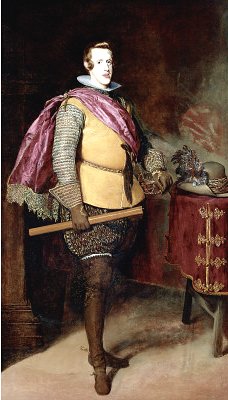While he was known primarily for his portraiture he also painted excellent landscapes where his use of layer upon layer of glazes resulted in a distinctive fluidity and lightness. His only historic painting, "The Surrender of Breda", has been described as one of the largest and one of the most detailed canvases in the history of art. Overall, Velazquez's paintings were characterized by classic clarity, simplicity, dignity and truth. Velazquez was ever the courtier and gentleman who maintained a high standing in the Spanish court where his fine manners, sense of humor and decent family life were much admired. In later years he was admired by both Goya and Manet. Subject: Philip was a kindly man who enjoyed life. He was fond of good food, sex, plays, pictures and hunting. It is said that he sired thirty-two (32) natural children of whom he acknowledged eight (8). In 1644 his wife, Isabel of Bourbon and his son Balthasar Carlos both died. Anxious for an heir he married his fourteen (14) year old niece Mariana of Austria. She bore him two sons, one of whom became the future Charles II. Philip was generous to artists and authors. Painting, sculpture, poetry and drama all flourished during his reign as never before or since. He became a great patron and connoisseur of art and was particularly fond of the work of Velazquez who painted many portraits of the king, the royal family and other royal favorites. It is said that he frequentd Velazquez's studio on many occasions and enjoyed watching him work. The painting "Las Meninas" shows the king and queen present while Velazquez paints a picture of the Infanta Margarita and her attendants. Painting: Philip is seen dressed in a yellow jerkin, with sleeves and trunk of brown, richly embroidered in gold. He wears high riding boots, has a crimson scarf over his shoulder and his gloved hand holds a marshall's baton - a symbol of authority. His plumed hat with a wide brim, pearl and feather decorations is placed on the table by his side. The pose is the same as seen in the portrait in the Prado, Madrid which shows the same youthful appearance of the young king, suggesting it to be a work of the 1627-28 period. Radiographic examination of the painting shows that beneath the present painting the king was originally clad in armor. Today the repainting (pentimenti) is visible to the naked eye, particularly in the outline of the monarch's cape, the position of the table and the armor. It indicates the young artist's search for the appropriate image to portray the powerful king. The excellent quality of the picture as a whole has been recognized, particularly the masterly brushwork of the head, hands and scarf. The work is considered to be one of the finest works from the 1627-28 period having been most recently exhibited in the1985 Brussells exhibition and the Velazquez exhibition at the Metropolitan Museum in New York in 1989. The painting was part of the collection of the Prince of Oranien, Brussels in 1883 , of the Sir George Holford collection, Dorchester House, London in 1853 and was sold at Christies, London 1928. Historical Context:
|
